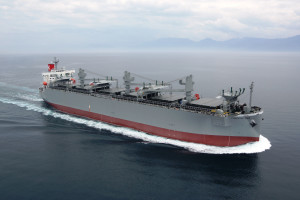Positive trends continue into 2017 centennial year
- P & I and FD & D entries grow by 16% and 19% respectively during 2016.
- 2016 policy year premium flat, but financial year revenue grows by 17%.
- Tonnage and premium increase by further 6% through June 2017.
- Membership risk profile continues to improve.
- Attritional claims developing favorably, in line with earlier years.
- Pool claims continue at moderate levels.
- 2014 policy year closed without call in excess of original estimate.
- 2015 policy year release call margin reduced from 15% to 10%.
- Eagle Ocean Marine continues to gain market share with excellent profitability.
- American Hellenic Hull gains Solvency II licensing, early growth exceeds expectations.
- Houston office opened to extend Club’s capabilities in US gulf and beyond.
- Club’s surpluses move strongly upward over first quarter of 2017.

Joe Hughes, Chairman and CEO of the American Club’s managers, Shipowners Claims Bureau, Inc.
NEW YORK, JUNE 23, 2017: Despite a challenging business climate, the American Club reported solid progress during 2016, the closing year of its first century of service to the global shipping community. Members attending the one-hundredth Annual Meeting of the Club in New York yesterday heard that its business was developing positively and that 2017, its centennial year, had started on an upbeat note.
Club tonnage had grown substantially during 2016 – P & I entries by 16% and FD & D business by 19%. 2017 had also started well in this respect, both tonnage and premiumhaving grown by 6% over the four months since renewal. It was also encouraging that the business renewed by the Club continued to enjoy a favorable risk profile, with a trailing five-year loss ratio of only 51%.
The results of the financial year to December 31, 2016 disclosed a small operating loss of just under $2 million. Total premium was up 17% for the year at $95.3 million, as were net investment income and net realized investment gains which, at just under $7 million, were about 13% higher than 2015 ($6.2 million). However, losses and other expenses had risen from $83.3 million to $108.5 million, mainly due to two claims of unusual severity during the course of the 2016 policy year. This, combined with a small unrealized loss on investments of $2.9 million, had generated a total Members’ Equity at year-end of $51.4 million, just under $5 million less than it had been at the end of 2015.
Encouragingly, however, the Club’s surpluses had risen substantially as of March 31, 2017, by which time the balance of premium for the 2016 policy year had been fully recognized. The Club’s GAAP surplus had grown over the quarter by 17% to $60 million, a figure about 9% above that recorded twelve months earlier. Its statutory surplus also rose by nearly 10%, to $72.8 million.
Loss development continued to follow the favorable trends of recent years. Claims for 2015 were still at comparatively low levels and had moved the year into respectable surplus. Attritional exposures for the 2016 policy year were developing at a level largely the same as they had been for 2015 at a similar stage. Claims for the 2017 policy year, albeit at a very early point of development, were following the positive emergence of 2015 in particular. Losses within the International Group’s Pool also continued to develop favorably.
The Club’s investments had generated an overall return of some 2.4% during the period against a blended benchmark of 2.2%. This was a substantial improvement on the previous year’s return of only 28 basis points. It was a creditable result given the market uncertainties which prevailed during most of 2016.
The Club’s Eagle Ocean Marine fixed premium facility had performed strongly in 2016, and into the early part of 2017. With an aggregate combined ratio of just over 60%, the facility was making a very healthy contribution to mutual results.
Taking all these circumstances into account, the Club’s Board resolved formally to close the 2014 policy year without call in excess of the original forecast. At the same time, in view of its continuingly positive development, it was decided to reduce the release call margin for the 2015 policy year from 15% to 10%.
A highlight of 2016 had been the licensing of American Hellenic Hull by the Cypriot authorities. Fully capitalized and compliant under the Solvency II insurance regulations of the European Union, American Hellenic Hull had made excellent progress to date. Some 1700 vessels are now insured by the new company which continues to gain market share and promises to make a significant contribution to the Club’s business from a variety of perspectives over the years ahead.
On the service front, the Club’s Managers had opened an office in Houston, Texas in July, 2016 in order to extend the Club’s capabilities in the US Gulf and beyond.
In assessing the condition of the Club’s affairs in its centennial year, the Club’s Chairman, Arnold Witte of Donjon Marine Co. Inc., said: “2016 was yet another challenging period for the shipping industry and all those who serve its interests. But it was also a year of achievement for the American Club across a wide spectrum of activity. The Club remains well placed to exploit opportunities in the future. In this special, centennial year, my fellow Directors and I wish to thank the Members, and all those who act on their behalf, for their continuing support as we move into our second century of service to the global maritime community.”
Joe Hughes, Chairman and CEO of the American Club’s Managers, Shipowners Claims Bureau Inc., echoed Mr. Witte’s remarks: “Notwithstanding difficult business conditions, 2016 was a solid year for the American Club. It advanced its business in many areas as the year unfolded. It was particularly encouraging to see a solid increase in tonnage, a trend which has continued into 2017. Claims continue to develop favorably, revenue is growing despite a weak pricing environment, investments are performing well, membership is expanding, free reserves are increasing, and the Club’s service capabilities continue to be enlarged.”
He concluded: “As we reflect on the American Club’s first century, we will continue to exploit the energy and enthusiasm which have driven its recent progress, fortifying the Club’s prospects for further success over the years ahead.”
The Annual Meeting saw the election of Ms. Judy L. Collins of Patriot Contract Services, LLC, Concord, California and Mr. Gary K. Cutler of Poling & Cutler Marine Transportation, Inc. of Freehold, New Jersey, as new members of the Board.
The retirement of Mr. James P. Corcoran, an independent member of the Board, and a former Superintendent of Insurance for the State of New York, was also noted. Mr. Corcoran was thanked most warmly for his outstanding contribution to the Club’s affairs over many years of diligent service.
ENDS
Notes to Editors
The American Club
American Steamship Owners Mutual Protection and Indemnity Association, Inc. (the American Club) was established in New York in 1917. It is the only mutual Protection and Indemnity Club domiciled in the entire Americas and its headquarters are in New York, USA.
The American Club has been successful in recent years in building on its US heritage to create a truly international insurer with a global reach second-to-none in the industry. Day to day management of the American Club is provided by Shipowners Claims Bureau, Inc. also headquartered in New York.
The Club is able to provide local service for its members across all time zones, communicating in eleven languages, and has subsidiary offices located in London, Piraeus, Hong Kong, Shanghai and Houston, plus a worldwide network of correspondents.
The Club is a member of the International Group of P&I Clubs, a collective of thirteen mutuals which together provide Protection and Indemnity insurance for some 90% of all world shipping.
For more information, please visit the Club’s website http://www.american-club.com/
The full 2016 Annual Report for the American Club can be accessed on its website.
P&I Insurance
Protection and Indemnity insurance (commonly referred to as “P&I”) provides cover to shipowners and charterers against third-party liabilities encountered in their commercial operations; typical exposures include damage to cargo, pollution, death/injury or illness of passengers or crew or damage to docks and other installations.
Running in parallel with a ship’s hull and machinery cover, traditional P&I cover distinguishes itself from usual forms of marine insurance by being based on the not-for-profit principle of mutuality where Members of the Club are both the insurers and the assureds.







 NITY, EXEMPLIFYING NEW YORK’S OUTREACH TO THE WORLD.
NITY, EXEMPLIFYING NEW YORK’S OUTREACH TO THE WORLD.
